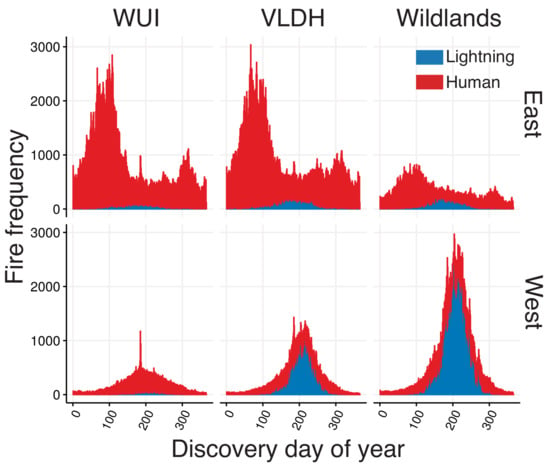In the Line of Fire: Consequences of Human-Ignited Wildfires to Homes in the U.S. (1992–2015)
Abstract
:1. Introduction
Hypotheses
2. Datasets
2.1. The Wildland-Urban Interface
2.2. U.S. Forest Service Fire Program Analysis-Fire-Occurrence Database
2.3. Monitoring Trends in Burn Severity
2.4. Zillow Transaction and Assessment Dataset
2.5. United States National Incident Command System Historical ICS-209 Reports
3. Methods
Accuracy Assessment
4. Results
4.1. Percent of All Wildfires Originated in the WUI
4.2. In the WUI, Humans Caused Nearly All Wildfires, Doubled Fire Season Length, and Increased the Number of Wildfires More than 20-Fold, Compared to Lightning-Started Wildfires
4.3. Suppression Costs were Significantly Higher When Protecting Homes
4.4. Sixty Million Residential Homes Cumulatively were Within One km of Human-Ignited Wildfires in the WUI
5. Discussion
Limitations
6. Conclusions
Supplementary Materials
Author Contributions
Funding
Acknowledgments
Conflicts of Interest
References
- Calkin, D.E.; Cohen, J.D.; Finney, M.A.; Thompson, M.P. How risk management can prevent future wildfire disasters in the wildland-urban interface. Proc. Natl. Acad. Sci. USA 2014, 111, 746–751. [Google Scholar] [CrossRef] [PubMed] [Green Version]
- Knorr, W.; Arneth, A.; Jiang, L. Demographic controls of future global fire risk. Nat. Clim. Chang. 2016, 6, 781–785. [Google Scholar] [CrossRef]
- Theobald, D.M.; Romme, W.H. Expansion of the US wildland–urban interface. Landsc. Urban Plan. 2007, 83, 340–354. [Google Scholar] [CrossRef]
- Hawbaker, T.J.; Radeloff, V.C.; Stewart, S.I.; Hammer, R.B.; Keuler, N.S.; Clayton, M.K. Human and biophysical influences on fire occurrence in the United States. Ecol. Appl. 2013, 23, 565–582. [Google Scholar] [CrossRef]
- Thomas, D.S.; Butry, D.T. Areas of the U.S. wildland–urban interface threatened by wildfire during the 2001–2010 decade. Nat. Hazards 2014, 71, 1561–1585. [Google Scholar] [CrossRef]
- Bowman, D.M.J.S.; Balch, J.; Artaxo, P.; Bond, W.J.; Cochrane, M.A.; D’Antonio, C.M.; DeFries, R.; Johnston, F.H.; Keeley, J.E.; Krawchuk, M.A.; et al. The human dimension of fire regimes on Earth. J. Biogeog. 2011, 38, 2223–2236. [Google Scholar] [CrossRef] [Green Version]
- Radeloff, V.C.; Helmers, D.P.; Kramer, H.A.; Mockrin, M.H.; Alexandre, P.M.; Bar-Massada, A.; Butsic, V.; Hawbaker, T.J.; Martinuzzi, S.; Syphard, A.D.; et al. Rapid growth of the US wildland-urban interface raises wildfire risk. Proc. Natl. Acad. Sci. USA 2018, 115, 3314. [Google Scholar] [CrossRef] [Green Version]
- Balch, J.K.; Bradley, B.A.; Abatzoglou, J.T.; Nagy, R.C.; Fusco, E.J.; Mahood, A.L. Human-started wildfires expand the fire niche across the United States. Proc. Natl. Acad. Sci. USA 2017, 114, 2946–2951. [Google Scholar] [CrossRef] [Green Version]
- Syphard, A.D.; Keeley, J.E.; Pfaff, A.H.; Ferschweiler, K. Human presence diminishes the importance of climate in driving fire activity across the United States. Proc. Natl. Acad. Sci. USA 2017. [Google Scholar] [CrossRef] [Green Version]
- Abatzoglou, J.T.; Kolden, C.A.; Williams, A.P.; Lutz, J.A.; Smith, A.M.S. Climatic influences on interannual variability in regional burn severity across western US forests. Int. J. Wildland Fire 2017, 26, 269–275. [Google Scholar] [CrossRef]
- Jolly, W.M.; Cochrane, M.A.; Freeborn, P.H.; Holden, Z.A.; Brown, T.J.; Williamson, G.J.; Bowman, D.M. Climate-induced variations in global wildfire danger from 1979 to 2013. Nat. Commun. 2015, 6, 1–11. [Google Scholar] [CrossRef]
- Abatzoglou, J.T.; Williams, A.P.; Boschetti, L.; Zubkova, M.; Kolden, C.A. Global patterns of interannual climate–fire relationships. Glob. Chang. Biol. 2018. [Google Scholar] [CrossRef] [PubMed]
- Parks, S.A.; Holsinger, L.M.; Miller, C.; Nelson, C.R. Wildland fire as a self-regulating mechanism: The role of previous burns and weather in limiting fire progression. Ecol. Appl. 2015, 25, 1478–1492. [Google Scholar] [CrossRef] [PubMed]
- Higuera, P.E.; Abatzoglou, J.T.; Littell, J.S.; Morgan, P. The Changing Strength and Nature of Fire-Climate Relationships in the Northern Rocky Mountains, U.S.A., 1902–2008. PLoS ONE 2015, 10, e0127563. [Google Scholar] [CrossRef] [Green Version]
- Schoennagel, T.; Balch, J.K.; Brenkert-Smith, H.; Dennison, P.E.; Harvey, B.J.; Krawchuk, M.A.; Mietkiewicz, N.; Morgan, P.; Moritz, M.A.; Rasker, R.; et al. Adapt to more wildfire in western North American forests as climate changes. Proc. Natl. Acad. Sci. USA 2017, 114, 4582–4590. [Google Scholar] [CrossRef] [Green Version]
- Gorte, R. The Rising Cost of Wildfire Protection; Headwaters Economics: Bozeman, MT, USA, 2013; Available online: https://headwaterseconomics.org/wp-content/uploads/fire-costs-background-report.pdf (accessed on 3 September 2020).
- Liu, Z.; Wimberly, M.C. Direct and indirect effects of climate change on projected future fire regimes in the western United States. Sci. Total Environ. 2016, 542, 65–75. [Google Scholar] [CrossRef] [PubMed] [Green Version]
- Liu, J.C.; Mickley, L.J.; Sulprizio, M.P.; Dominici, F.; Yue, X.; Ebisu, K.; Anderson, G.B.; Khan, R.F.; Bravo, M.A.; Bell, M.L. Particulate air pollution from wildfires in the Western US under climate change. Clim. Chang. 2016, 138, 655–666. [Google Scholar] [CrossRef] [PubMed] [Green Version]
- Dennison, P.E.; Brewer, S.C.; Arnold, J.D.; Moritz, M.A. Large wildfire trends in the western United States, 1984–2011. Geophys. Res. Lett. 2014, 41, 2928–2933. [Google Scholar] [CrossRef]
- NIFC. Federal Firefighting Costs (Suppression Only). Available online: https://www.nifc.gov/fireInfo/fireInfo_documents/SuppCosts.pdf (accessed on 9 June 2020).
- Fusco, E.J.; Abatzoglou, J.T.; Balch, J.K.; Finn, J.T.; Bradley, B.A. Quantifying the human influence on fire ignition across the western USA. Ecol. Appl. 2016, 26, 2390–2401. [Google Scholar] [CrossRef] [Green Version]
- Syphard, A.D.; Radeloff, V.C.; Keeley, J.E.; Hawbaker, T.J.; Clayton, M.K.; Stewart, S.I.; Hammer, R.B. Human influence on California fire regimes. Ecol. Appl. 2007, 17, 1388–1402. [Google Scholar] [CrossRef] [PubMed]
- Syphard, A.D.; Keeley, J.E. Location, timing and extent of wildfire vary by cause of ignition. Int. J. Wildland Fire 2015, 24, 37–47. [Google Scholar] [CrossRef]
- Braswell, A.E.; Leyk, S.; Connor, D.; Uhl, J. Historical Development of the Coastal United States: Evolution of Areas Vulnerable to Sea Level Rise. Nat. Commun. 2020. Submitted. [Google Scholar]
- Modugno, S.; Balzter, H.; Cole, B.; Borrelli, P. Mapping regional patterns of large forest fires in Wildland–Urban Interface areas in Europe. J. Environ. Manag. 2016, 172, 112–126. [Google Scholar] [CrossRef] [PubMed]
- Malamud, B.D.; Millington, J.D.A.; Perry, G.L.W. Characterizing wildfire regimes in the United States. Proc. Natl. Acad. Sci. USA 2005, 102, 4694–4699. [Google Scholar] [CrossRef] [PubMed] [Green Version]
- Short, K. Spatial Wildfire Occurrence Data for the United States, 1992–2015 [FPA_FOD_20170508], 4th ed.; Forest Service Research Data Archive: Fort Collins, CO, USA, 2017. [Google Scholar] [CrossRef]
- Leyk, S.; Uhl, J.H. HISDAC-US, historical settlement data compilation for the conterminous United States over 200 years. Sci. Data 2018, 5, 180175. [Google Scholar] [CrossRef] [PubMed]
- St. Denis, L.A.; Mietkiewicz, N.P.; Short, K.C.; Buckland, M.; Balch, J.K. All-hazards dataset mined from the US National Incident Management System 1999–2014. Sci. Data 2020, 7, 64. [Google Scholar] [CrossRef] [PubMed] [Green Version]
- Aronson, G.; Kulakowski, D. Bark beetle outbreaks, wildfires and defensible space: How much area do we need to treat to protect homes and communities? Int. J. Wildland Fire 2012, 22, 256–265. [Google Scholar] [CrossRef]
- Schoennagel, T.; Nelson, C.R.; Theobald, D.M.; Carnwath, G.C.; Chapman, T.B. Implementation of National Fire Plan treatments near the wildland–urban interface in the western United States. Proc. Natl. Acad. Sci. USA 2009, 106, 10706–10711. [Google Scholar] [CrossRef] [Green Version]
- Martinuzzi, S.; Stewart, S.I.; Helmers, D.P.; Mockrin, M.H.; Hammer, R.B.; Radeloff, V.C. The 2010 wildland-urban interface of the conterminous United States. In Research Map NRS-8; Department of Agriculture, Forest Service, Northern Research Station: Newtown Square, PA, USA, 2015; 124p. [Google Scholar]
- Short, K. Sources and implications of bias and uncertainty in a century of US wildfire activity data. Int. J. Wildland Fire 2015, 24, 883–891. [Google Scholar] [CrossRef]
- Eidenshink, J.; Schwind, B.; Brewer, K.; Zhu, Z.-L.; Quayle, B.; Howard, S. A project for monitoring trends in burn severity. Fire Ecol. 2007, 3, 3–21. [Google Scholar] [CrossRef]
- Wickham, J.D.; Stehman, S.V.; Gass, L.; Dewitz, J.; Fry, J.A.; Wade, T.G. Accuracy assessment of NLCD 2006 land cover and impervious surface. Remote Sens. Environ. 2013, 130, 294–304. [Google Scholar] [CrossRef]
- Krawchuk, M.A.; Moritz, M.A.; Parisien, M.A.; Van Dorn, J.; Hayhoe, K. Global pyrogeography: The current and future distribution of wildfire. PLoS ONE 2009, 4. [Google Scholar] [CrossRef] [PubMed]
- Syphard, A.D.; Keeley, J.E.; Massada, A.B.; Brennan, T.J.; Radeloff, V.C. Housing Arrangement and Location Determine the Likelihood of Housing Loss Due to Wildfire. PLoS ONE 2012, 7, e33954. [Google Scholar] [CrossRef] [PubMed] [Green Version]
- Fusco, E.J.; Finn, J.T.; Abatzoglou, J.T.; Balch, J.K.; Dadashi, S.; Bradley, B.A. Detection rates and biases of fire observations from MODIS and agency reports in the conterminous United States. Remote Sens. Environ. 2019, 220, 30–40. [Google Scholar] [CrossRef]
- USFS. The National Strategy. 2014. Available online: https://www.forestsandrangelands.gov/strategy/documents/strategy/CSPhaseIIINationalStrategyApr2014.pdf (accessed on 3 November 2017).
- Wildland Fire Leadership Council. Cohesive Strategy Crosswalk and Strategic Alignment. Available online: https://www.forestsandrangelands.gov/documents/strategy/reports/cohesive_strategy_crosswalk_and_strategic_alignment_report.pdf (accessed on 9 June 2020).
- Westerling, A.L. Increasing western US forest wildfire activity: Sensitivity to changes in the timing of spring. Philos. Trans. R. Soc. Lond. B Biol. Sci. 2016, 371. [Google Scholar] [CrossRef]
- Westerling, A.L.; Hidalgo, H.G.; Cayan, D.R.; Swetnam, T.W. Warming and earlier spring increase western U.S. forest wildfire activity. Science 2006, 313, 940–943. [Google Scholar] [CrossRef] [Green Version]
- Abatzoglou, J.T.; Williams, A.P. Impact of anthropogenic climate change on wildfire across western US forests. Proc. Natl. Acad. Sci. USA 2016, 113, 11770–11775. [Google Scholar] [CrossRef] [Green Version]
- Goss, M.; Swain, D.L.; Abatzoglou, J.T.; Sarhadi, A.; Kolden, C.A.; Williams, A.P.; Diffenbaugh, N.S. Climate change is increasing the likelihood of extreme autumn wildfire conditions across California. Environ. Res. Lett. 2020, 15, 094016. [Google Scholar] [CrossRef] [Green Version]
- Allen, C.D.; Breshears, D.D.; McDowell, N.G. On underestimation of global vulnerability to tree mortality and forest die-off from hotter drought in the Anthropocene. Ecosphere 2015, 6, 121–155. [Google Scholar] [CrossRef]
- Park Williams, A.; Cook, B.I.; Smerdon, J.E.; Bishop, D.A.; Seager, R.; Mankin, J.S. The 2016 Southeastern U.S. Drought: An Extreme Departure From Centennial Wetting and Cooling. J. Geophys. Res. Atmos. 2017, 122, 10888–10905. [Google Scholar] [CrossRef]
- Nagy, R.C.; Fusco, E.; Bradley, B.; Abatzoglou, J.T.; Balch, J. Human-Related Ignitions Increase the Number of Large Wildfires across U.S. Ecoregions. Fire 2018, 1, 4. [Google Scholar] [CrossRef] [Green Version]
- Balch, J.; Schoennagel, T.; Williams, A.; Abatzoglou, J.; Cattau, M.; Mietkiewicz, N.; St. Denis, L. Switching on the Big Burn of 2017. Fire 2018, 1, 17. [Google Scholar] [CrossRef] [Green Version]
- Abatzoglou, J.T.; Balch, J.K.; Bradley, B.A.; Kolden, C.A. Human-related ignitions concurrent with high winds promote large wildfires across the USA. Int. J. Wildland Fire 2018, 27, 377–386. [Google Scholar] [CrossRef]
- Williams, A.P.; Abatzoglou, J.T.; Gershunov, A.; Guzman-Morales, J.; Bishop, D.A.; Balch, J.K.; Lettenmaier, D.P. Observed impacts of anthropogenic climate change on wildfire in California. Earth’s Future 2019, 7. [Google Scholar] [CrossRef] [Green Version]
- Ganteaume, A.; Barbero, R. Contrasting large fire activity in the French Mediterranean. Nat. Hazards Earth Syst. Sci. 2019, 19, 1055–1066. [Google Scholar] [CrossRef] [Green Version]
- Barbero, R.; Abatzoglou, J.; Larkin, N.; Kolden, C.; Stocks, B. Climate change presents increased potential for very large fires in the contiguous United States. Int. J. Wildland Fire 2015, 10, 1071. [Google Scholar] [CrossRef]
- Krawchuk, M.A.; Moritz, M.A. Constraints on global fire activity vary across a resource gradient. Ecology 2011, 92, 121–132. [Google Scholar] [CrossRef]
- Moritz, M.A.; Batllori, E.; Bradstock, R.A.; Gill, A.M.; Handmer, J.; Hessburg, P.F.; Leonard, J.; McCaffrey, S.; Odion, D.C.; Schoennagel, T.; et al. Learning to coexist with wildfire. Nature 2014, 515, 58–66. [Google Scholar] [CrossRef]
- Holden, Z.A.; Swanson, A.; Luce, C.H.; Jolly, W.M.; Maneta, M.; Oyler, J.W.; Warren, D.A.; Parsons, R.; Affleck, D. Decreasing fire season precipitation increased recent western US forest wildfire activity. Proc. Natl. Acad. Sci. USA 2018. [Google Scholar] [CrossRef] [Green Version]
- Uhl, J.; Leyk, S.; McShane, C.; Braswell, A.; Connor, D.; Balk, D. Fine-grained, spatio-temporal datasets measuring 200 years of land development in the United States. Earth Syst. Sci. Data 2020. [Google Scholar] [CrossRef]
- Donovan, G.H.; Brown, T.C. Be careful what you wish for: The legacy of Smokey Bear. Front. Ecol. Environ. 2007, 5, 73–79. [Google Scholar] [CrossRef] [Green Version]
- Brenkert-Smith, H.; Dickinson, K.L.; Champ, P.A.; Flores, N. Social Amplification of Wildfire Risk: The Role of Social Interactions and Information Sources. Risk Anal. 2013, 33, 800–817. [Google Scholar] [CrossRef] [PubMed]
- Anderson, S.E.; Bart, R.R.; Kennedy, M.C.; MacDonald, A.J.; Moritz, M.A.; Plantinga, A.J.; Tague, C.L.; Wibbenmeyer, M. The dangers of disaster-driven responses to climate change. Nat. Clim. Chang. 2018. [Google Scholar] [CrossRef]
- Cohen, J.D. Preventing disaster: Home ignitability in the wildland-urban interface. J. For. 2000, 98, 15–21. [Google Scholar]
- Cohen, J.D. Relating flame radiation to home ignition using modeling and experimental crown fires. Can. J. For. Res. 2004, 34, 1616–1626. [Google Scholar] [CrossRef]
- Syphard, A.D.; Brennan, T.J.; Keeley, J.E. The importance of building construction materials relative to other factors affecting structure survival during wildfire. Int. J. Disaster Risk Reduct. 2017, 21, 140–147. [Google Scholar] [CrossRef]
- Hamilton, M.; Fischer, A.P.; Guikema, S.D.; Keppel-Aleks, G. Behavioral adaptation to climate change in wildfire-prone forests. Wiley Interdiscip. Rev. Clim. Chang. 2018, 9, e553. [Google Scholar] [CrossRef]
- Moritz, M.A.; Knowles, S.G. Coexisting with wildfire. Am. Sci. 2016, 104, 220–227. [Google Scholar] [CrossRef]
- Kolden, C.A. We’re Not Doing Enough Prescribed Fire in the Western United States to Mitigate Wildfire Risk. Fire 2019, 2, 30. [Google Scholar] [CrossRef] [Green Version]
- Tedim, F.; Leone, V.; Amraoui, M.; Bouillon, C.; Coughlan, R.M.; Delogu, M.G.; Fernandes, M.P.; Ferreira, C.; McCaffrey, S.; McGee, K.T.; et al. Defining Extreme Wildfire Events: Difficulties, Challenges, and Impacts. Fire 2018, 1, 9. [Google Scholar] [CrossRef] [Green Version]
- Joseph, M.B.; Rossi, M.W.; Mietkiewicz, N.P.; Mahood, A.L.; Cattau, M.E.; St. Denis, L.A.; Nagy, R.C.; Iglesias, V.; Abatzoglou, J.T.; Balch, J.K. Understanding and predicting extreme wildfires in the contiguous United States. Ecol. Appl. 2019, 29, e01898. [Google Scholar] [PubMed] [Green Version]
- Koo, E.; Pagni, P.J.; Weise, D.R.; Woycheese, J.P. Firebrands and spotting ignition in large-scale fires. Int. J. Wildland Fire 2010, 19, 818–843. [Google Scholar] [CrossRef] [Green Version]
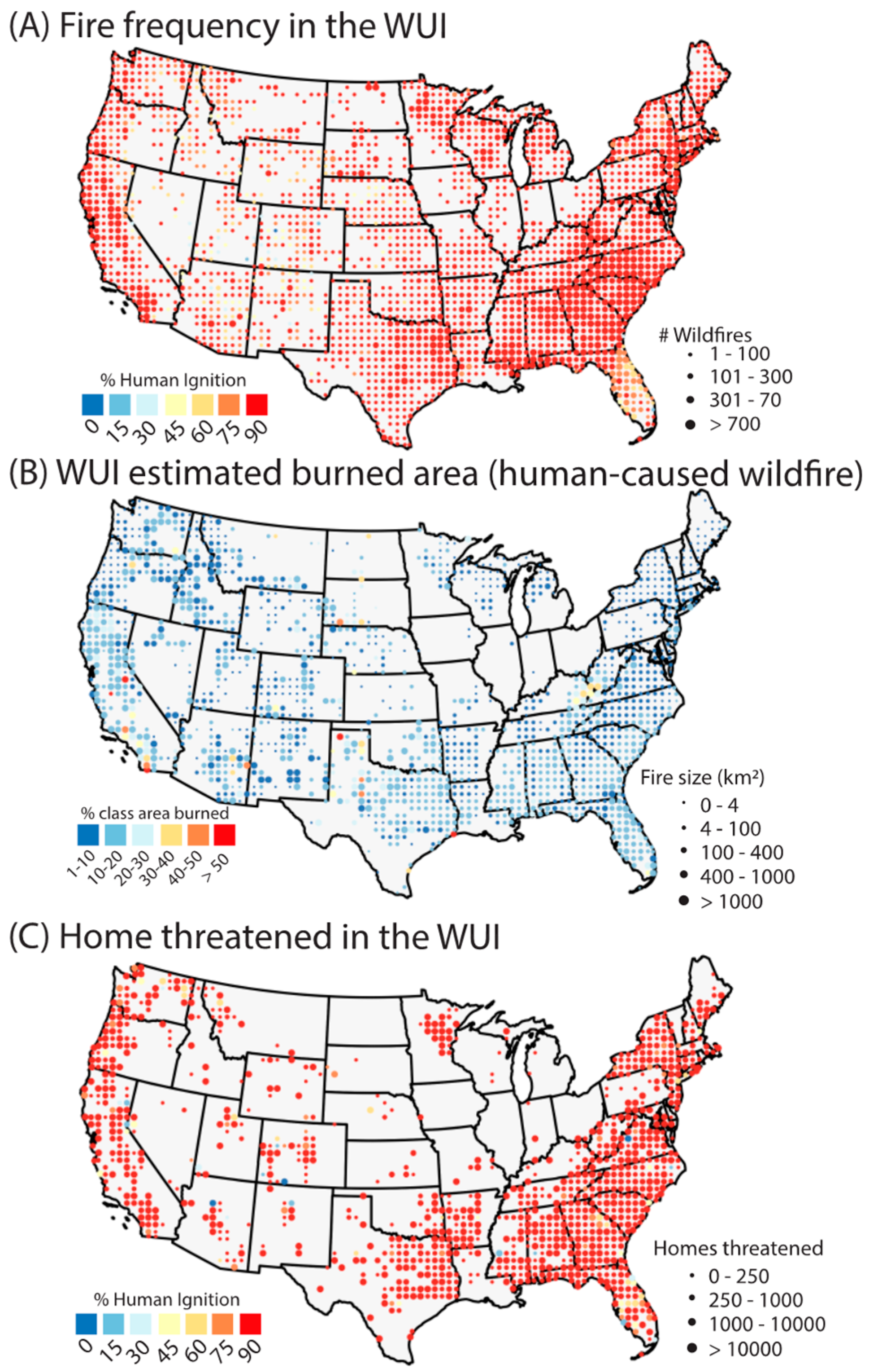
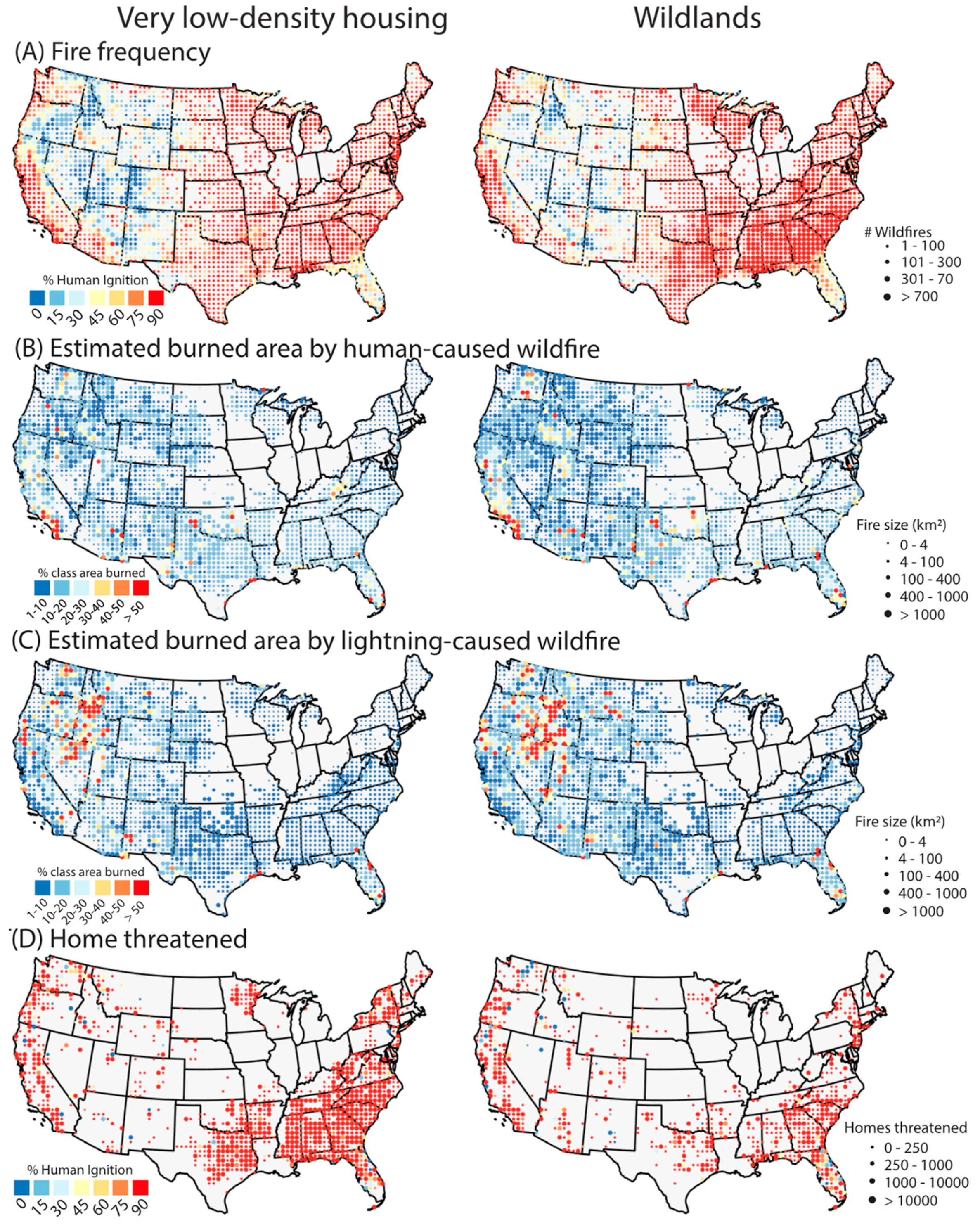

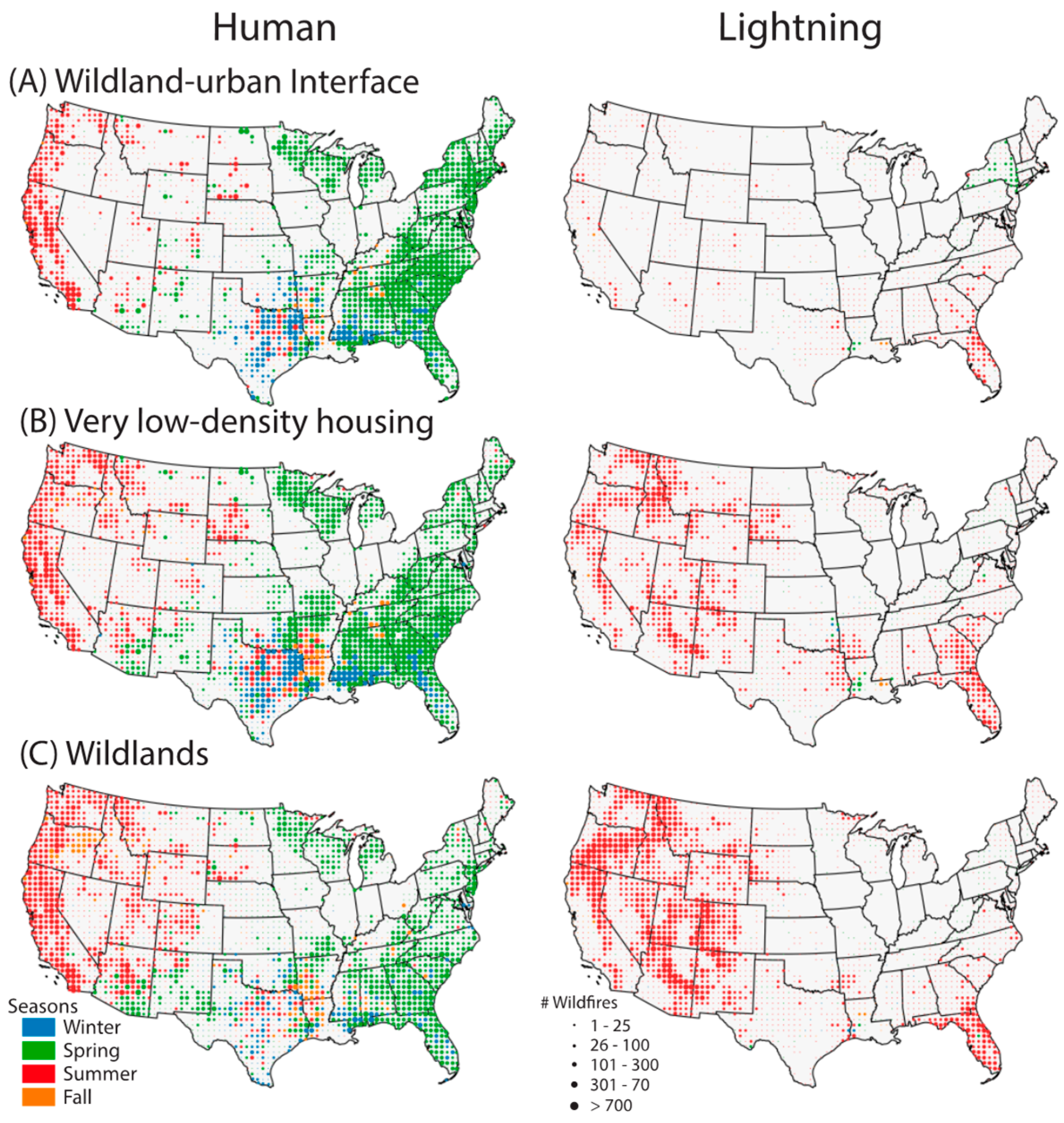
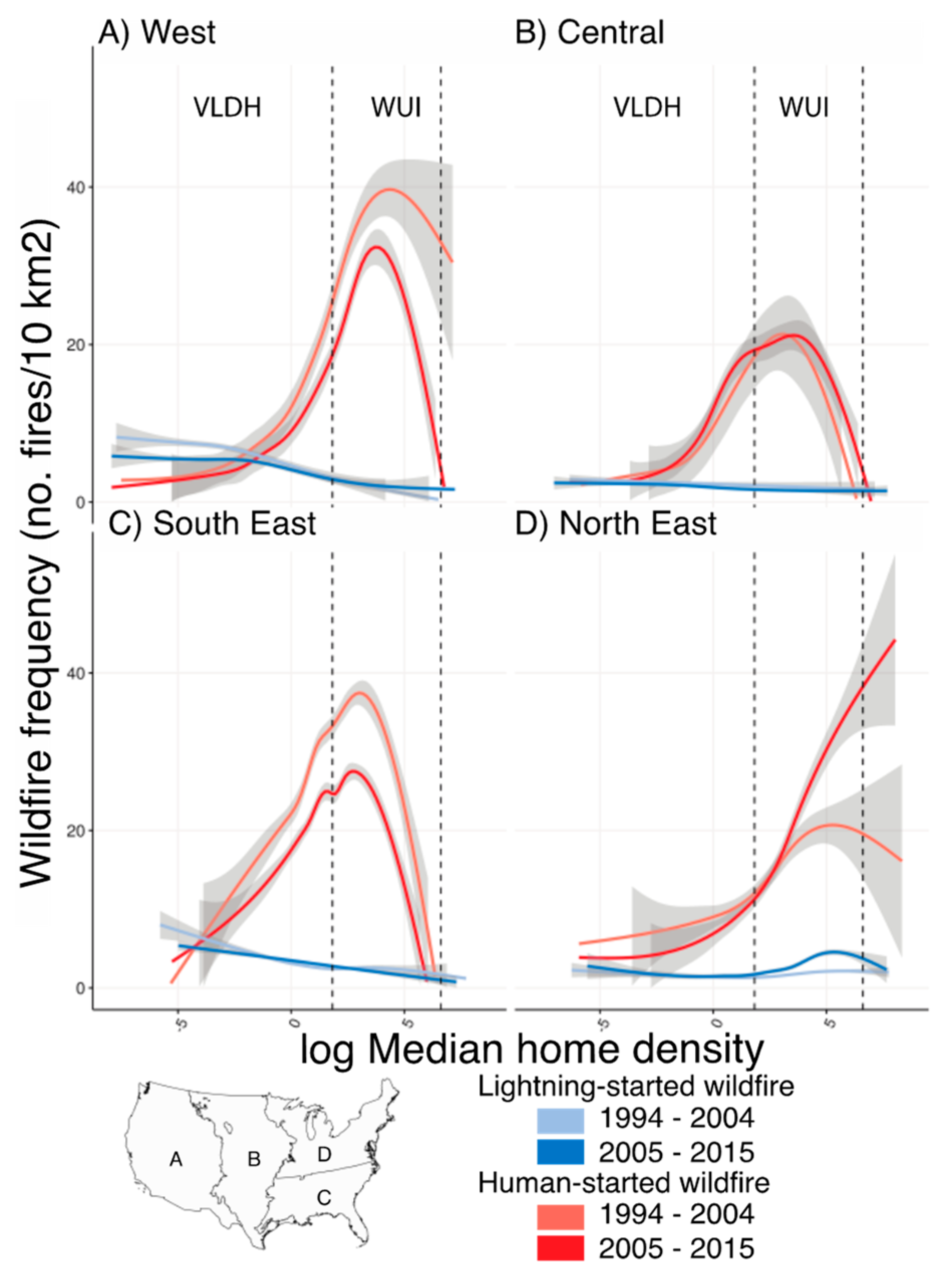

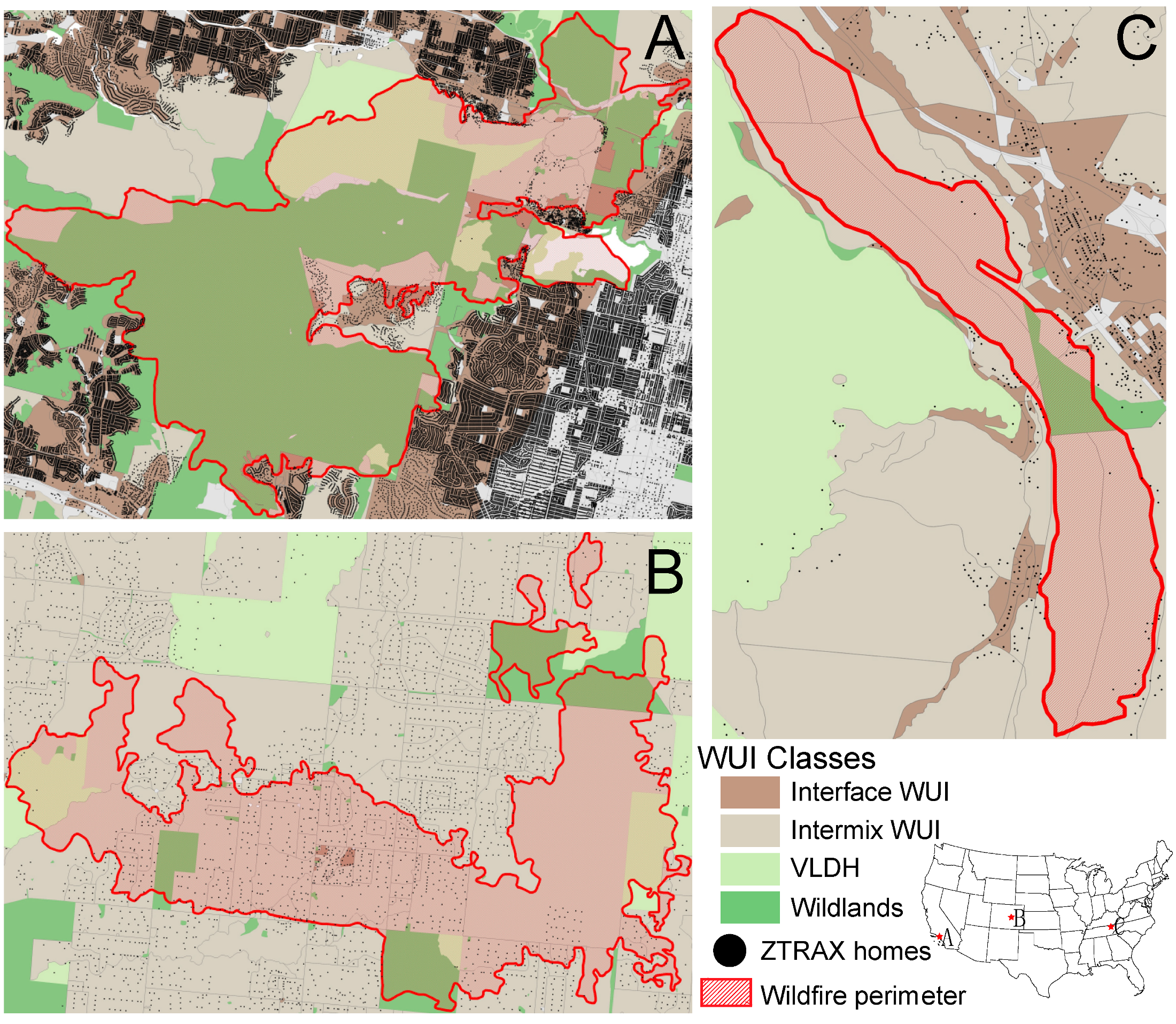
| WUI | VLDH | Wildlands | ||||
|---|---|---|---|---|---|---|
| Human | Lightning | Human | Lightning | Human | Lightning | |
| Cumulative Wildfire Ignitions | 424,700 | 12,594 | 459,054 | 82,645 | 242,047 | 166,135 |
| Cumulative Wildfire Burn Area (km2) | 15,511 | 1015 | 59,354 | 68,983 | 82,934 | 155,044 |
| Cumulative Class Burn Area (km2) | 12,411 | 886 | 74,570 | 104,286 | 105,410 | 221,047 |
| Average Fire Season Length (d) | 148 | 72 | 164 | 45 | 141 | 42 |
| Median Discovery Day | 126 | 188 | 129 | 207 | 173 | 208 |
| Cumulative Suppression Costs ($) | $ 430,272,129 | $ 199,042,135 | $ 1,075,374,500 | $ 3,707,201,330 | $ 2,684,643,910 | $ 6,497,038,360 |
| Cumulative Residential Structures Threatened: Within Fire | 1,037,018 | 36,215 | 127,570 | 9,621 | 132,708 | 13,333 |
| Cumulative Residential Structures Threatened: Edge–250 m | 4,496,568 | 129,131 | 441,821 | 23,946 | 366,660 | 23,943 |
| Cumulative Residential Structures Threatened: 250–500 m | 11,868,411 | 349,220 | 1,165,255 | 61,064 | 1,162,470 | 77,845 |
| Cumulative Residential Structures Threatened: 500–1000 m | 42,448,101 | 1,273,532 | 4,811,475 | 277,824 | 6,185,076 | 426,951 |
| Cumulative Residential Structures Threatened: Within Fire–1000 m | 59,850,098 | 1,788,098 | 6,546,121 | 372,455 | 7,846,914 | 542,072 |
© 2020 by the authors. Licensee MDPI, Basel, Switzerland. This article is an open access article distributed under the terms and conditions of the Creative Commons Attribution (CC BY) license (http://creativecommons.org/licenses/by/4.0/).
Share and Cite
Mietkiewicz, N.; Balch, J.K.; Schoennagel, T.; Leyk, S.; St. Denis, L.A.; Bradley, B.A. In the Line of Fire: Consequences of Human-Ignited Wildfires to Homes in the U.S. (1992–2015). Fire 2020, 3, 50. https://0-doi-org.brum.beds.ac.uk/10.3390/fire3030050
Mietkiewicz N, Balch JK, Schoennagel T, Leyk S, St. Denis LA, Bradley BA. In the Line of Fire: Consequences of Human-Ignited Wildfires to Homes in the U.S. (1992–2015). Fire. 2020; 3(3):50. https://0-doi-org.brum.beds.ac.uk/10.3390/fire3030050
Chicago/Turabian StyleMietkiewicz, Nathan, Jennifer K. Balch, Tania Schoennagel, Stefan Leyk, Lise A. St. Denis, and Bethany A. Bradley. 2020. "In the Line of Fire: Consequences of Human-Ignited Wildfires to Homes in the U.S. (1992–2015)" Fire 3, no. 3: 50. https://0-doi-org.brum.beds.ac.uk/10.3390/fire3030050




